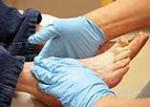According to a 2009 report by the International Diabetes Federation, 7% of the world’s population has diabetes. That’s approximately 300 million people worldwide with the majority of cases (85% – 95%) having Type 2 Diabetes. Type 2 Diabetes is preventable in 60% of cases, according to the IDF.
At McDermott Footcare, almost half of the clientele have Type 2 Diabetes. All of the clients exhibit neuropathic and circulatory deficits which negatively affect the health of their feet and lower legs. Read here about neuropathic and circulatory changes.
The following case studies illustrate the importance of regular nursing foot care for diabetics:
Case Study #1
Client A is a nursing home resident. He was a McDermott Footcare client when he lived at home; at the family’s request, McDermott Footcare has continued his foot care in the nursing home. On a recent foot care visit, he told me that he had stubbed and cut his toe. He noticed some discharge coming from the cut. He did not tell the staff nurses and they did not notice the injury. On closer inspection, I noticed redness, inflammation and a white discharge when I squeezed the toe, all symptoms indicative of infection. I cleaned and bandaged the injury site. I reported the injury to Client A’s family, the Charge Nurse, the Director of Care and requested that my client be seen ASAP by the doctor-on-call. Within 2 hours, Client A’s family received a phone call informing them that the doctor had just seen their father and antibiotics were now prescribed.

Case Study #2
When I first saw Client B 12 weeks ago, he exhibited Tinea Pedis (Athlete’s Foot). The fungal infection completely covered the bottom of both feet, as well as along the sides and top of the feet. It was starting to spread upwards towards his ankles. He had large areas of peeling, scaling, redness and itching. Upon inquiry, I learned that Client B likes to sleep with his socks and shoes on because his feet are extremely cold at night. During the day, he continues to wear the same shoes. I discussed a Plan of Care with Client B and his caregivers. I recommended thick, cotton, breathable diabetic socks for nighttime use and advised my client to stop wearing shoes to bed. I suggested leather or cloth slippers for daytime use at home. Athlete’s Foot fungus (read here) thrives in dark, moist places. Constantly wearing shoes provides the perfect opportunity for the fungus to grow. I taught the caregivers how to make a vinegar-water foot soak, how to properly dry Client B’s feet and advised Client B to get a prescription anti-fungal medication from his doctor. 6 weeks later, most of the Athlete’s Foot infection was gone, with only a small amount of scaling and peeling on the bottoms of his feet.
Diabetics are at a higher risk for foot-related infections leading to lower limb amputation. This is because of neuropathy and micro/macroangiopathy. Since their feet have decreased sensation, diabetics may not realize that they have an infected cut or open sore on the feet. Decreased eyesight in diabetics means that they may not be able to see the cut or open sore. Poor circulation means that the ability to fight the infection is compromised.
My main concern with both clients was eliminating the infection. The whitish discharge, redness and inflammation of Client A indicated a bacterial infection in his toe. Client B’s Athlete’s Foot could have progressed to cellulitis with open sores. Knowing the appropriate nursing actions and referring both clients to their physician addressed their needs in a timely and effective fashion.
Being in regular contact with both clients, knowing their complete medical history and having up-to-date knowledge in diabetic nursing foot care prevented two situations from worsening. Regular visits from a certified foot care nurse effectively addresses the needs of diabetics.
On-going nursing assessments during visits are able to identify problem areas that the client and their family are unaware of. One of these assessments, mono-filament testing for neuropathy, determines changes in the client’s ability to detect sensations in the feet.

